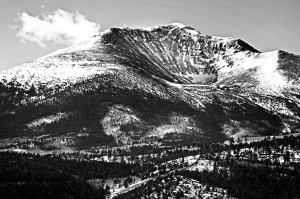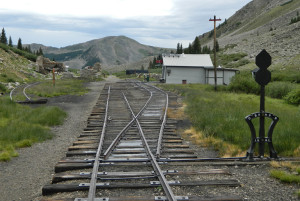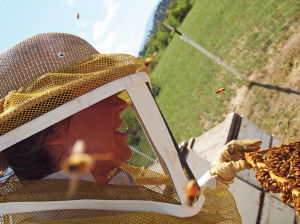By George Sibley
How do you conduct resource planning for a resource when you know the demand will increase, but the supply won’t, and might even decrease? And how does a generation which has a heritage of generally avoiding questions like that through technological fixes, prepare a plan for coming generations to actually address such questions with better political and economic infrastructure?
These are challenges that all the “water people” in Colorado today are working on. By “water people,” I mean the water providers who enable you to take for granted the water, without which there would be no life here at all. These water people include:
• The multitude of associations of agricultural irrigators.
• The army of water lawyers who (when they aren’t disrupting it) maintain the legal and political infrastructure underlying the physical infrastructure for water use which is maintained by another army of engineers and managers and accountants.
• The watershed environmental groups that are trying to clean up the messes left by a century of often careless use.
• All the businesses from the Culligan man to the rafting companies that depend on water being everywhere at once for whatever we want it for.
Since the turn of the century, Colorado water people have been worrying about the future water supply – partly nudged by a decade of mostly below-average water supply years, but mostly by the growing awareness of a finite (at best) water supply in an environment of human population growth and human-induced climate uncertainties. The state demographer projects that, by midcentury, Colorado will have between eight and 10 million people – roughly 60-100 percent more than today’s population of five million plus. Almost all of the new people will settle in the state’s urban and suburban areas, with 80 percent of them projected to move into the Front Range metropolis, from the Fort Collins area to the north to the Pueblo area to the south.
Another thing we know is that virtually all of the state’s water resources – as much controlled by interstate compacts as by nature – are stressed. Most Coloradans are unaware of this because the stuff keeps coming out of the faucet pretty affordably – and it’s even okay most places to let it pour out of the garden hose. But all of the rivers and streams are over-appropriated, which is to say that, in all but the wettest of years, there is not enough water to fill all of the demands on them. There is what might be called an “urban myth” that the Colorado River tributaries should, on paper at least, have some water available to help meet intrastate water demands as well as interstate demands. But, the people who live in those tributaries are not convinced, and worry that they will get stuck with the bill if, or when, Colorado is found to be consuming too much of the river’s water when the interstate accounting comes due.
In 2003, the Colorado Water Conservation Board (Colorado’s water planning commission) began an in-depth analysis of the state’s water supply. The first “Statewide Water Supply Initiative” report in 2004 indicated that we literally do not know where the water will come from to supply the projected new population growth. The “SWSI” study has since gone through two more reports, and statewide, “The Gap” between known supply and probable demand is now estimated at 200,000 to 600,000 acre-feet of water annually, just for municipal and industrial (M&I) uses, depending on how many people move here and with what promises. (For comparison, the Pueblo Reservoir holds around 350,000 acre-feet when full, so the statewide M&I Gap is the equivalent of the Pueblo Reservoir annually, give or take a couple hundred thousand acre-feet.)
In 2005, following the SWSI 1 report, the legislature created nine “Basin Roundtables,” one each for the eight major river basins in Colorado plus one for the “Metro” area around Denver (not a real watershed, but a place where lots of Colorado’s water collects). The purpose of the roundtables was to work with the Colorado Water Conservation Board and the SWSI study to determine each basin’s water needs and the water supplies available to meet those needs. Every basin except the small portion of the North Platte River in Colorado found that it had a future gap for both municipal and industrial uses and for agricultural uses (mostly stored water for late-season irrigation). Most of the basin M&I gaps seem manageable intrabasin. But the M&I gaps for the three East Slope basins that include all of the metropolitan region – the South Platte, Metro, and Arkansas Basins – make up four-fifths of the statewide M&I Gap, and it is clear that their dilemma can only be met through interbasin efforts.
This emerging challenge led Governor Hickenlooper, this past May, to order the Colorado Water Conservation Board to develop a state water plan for resolving the problem of The Gap at midcentury. The Basin Roundtables are all charged to begin this process by each preparing a Basin Implementation Plan – BIP – to resolve its own intrabasin supply challenges; out of these nine BIPs, a state water plan will then be developed. So we hope.
Whether intrabasin or interbasin, where will the “new” water come from to meet these Gaps? Realistically, there are three possible ways to reduce the municipal and industrial gaps in Colorado’s water future: conservation, transfers from agricultural water, and new supply projects. Here is a quick look at each possibility.
Conservation. Two types of conservation require our consideration. One is the conscious and active conservation when water suppliers ask their users to voluntarily reduce their water use through in-home, landscaping, industrial and agricultural efficiency measures. Suppliers know that people will voluntarily conserve in emergencies, like serious drought, but will they be so willing to cut their use in order to make more water available for growth – meaning more traffic, bigger crowds at the zoo, more pressure on all other resources, etc?
The other type of conservation is “upfront demand reduction” (or “passive conservation”). This is a preemptive measure to prevent inefficient or unnecessary water use from even occurring. Requiring efficient appliances and plumbing fixtures in all new construction and remodeling is upfront demand reduction. Land use planning that favors density over sprawl would be another. But Coloradans hold “local control” in land use planning to be almost sacred, and there is fierce competition for new development and the associated jobs and property taxes. Will it kill the Front Range economy if new development has to adopt the motto: “It’s the desert, live with it”?
And for the West Slope and non-urban East Slope – how should “rural” regions approach conservation, where most of the water is used agriculturally or recreationally? Most West Slope valleys will have little trouble addressing their modest M&I gaps, but preserving agricultural and recreational uses will be more difficult.
Transfers from Agriculture. This is already happening, but mostly through what newspapers call the “buy and dry” process, whereby agricultural land (or just its water) is bought by cities or developers and the water diverted to municipal and industrial uses elsewhere, essentially abandoning the land. This has always been through “willing sellers,” and some of that will continue to happen as retiring ranchers and farmers liquidate for their retirement fund; there will be “buy and replumb” situations where developers convert a farm to new developments. Either way, however, the communities that produce food for the region are weakened. The big question is then: can programs be developed for fallowing, interruptible supply in emergencies, deficit irrigation and the like, whereby sufficient water can be freed up as needed for M&I use without taking the land completely out of production? There are other questions, like what should ag-transfer water cost? Who should pay? And ultimately, some difficult questions about the relative values to society of different types of agriculture must be addressed. More about that another time.
New Supply. From a West Slope perspective, this discussion begins with the following question. Since the East Slope is already over-appropriated everywhere, is there actually any more water in the Upper Colorado River Basins that could be dependably developed, even in dry years (“firm yield”), for the metro region that has to reach beyond its own boundaries for more water? This discussion now revolves around consideration of the risk that any further major Upper Basin development might cause Upper Basin depletions exceeding the interstate compact obligation to the Lower Basin. West Slope water leaders believe that there may be “big water years” that would enable new supply for the Front Range, but not an annual firm yield to depend on. And most climate change studies project a diminishing Colorado River water supply throughout the century. Can the cities of the plains risk a billion dollar investment in an uncertain supply with very junior water rights? Again, difficult questions about the relative value to society of different uses for water lurk beneath this question.
None of this says anything about the agricultural users’ late-season shortages – a cumulative gap larger than the M&I gap statewide. This is mostly a problem of expensive additional storage, which the agricultural users themselves cannot afford, and that is probably the end of that discussion. Rio Grande Basin farmers have bitten that bullet. They are taxing themselves to take marginal land out of production, while increasing efficiency on other lands.
Realistically, probably most of the water absolutely needed to address the future shortages, from here forward, will come from a combination of upfront demand reduction, and hopefully enlightened transfers from agriculture. That is to say, water already in use shifted from current use to new domestic uses – a process actually anticipated in the state constitution (Article XVI, Sec. 6).
BIPs addressing these questions in an intrabasin way are now being drafted in all of Colorado’s river basins. The interbasin “horse trading” will probably begin early next year, as Front Range metropolitan water providers in the upper South Platte and middle-Arkansas basins remind the state that, constitutionally, all of the state’s water belongs to all the state’s people, and that their Gap problem is every Coloradan’s problem, one way or another.
As a member of the Gunnison Basin Roundtable, I will be keeping Central Coloradans updated on this process – this effort to plan our future democratically in a grassroots, bottom-up kind of way. I will try to maintain a statewide overview on this, but since Central Colorado, as defined by that wily Ed Quillen, encompasses three headwaters basins (one containing part of the metropolis), it would be good for readers to keep up in their own ways on what is happening in their own basins, and to chastise me when my West Slope bias unconsciously shows.
George Sibley is well immersed in water issues, as a member of both the Gunnison Basin Roundtable and the Upper Gunnison River District.




